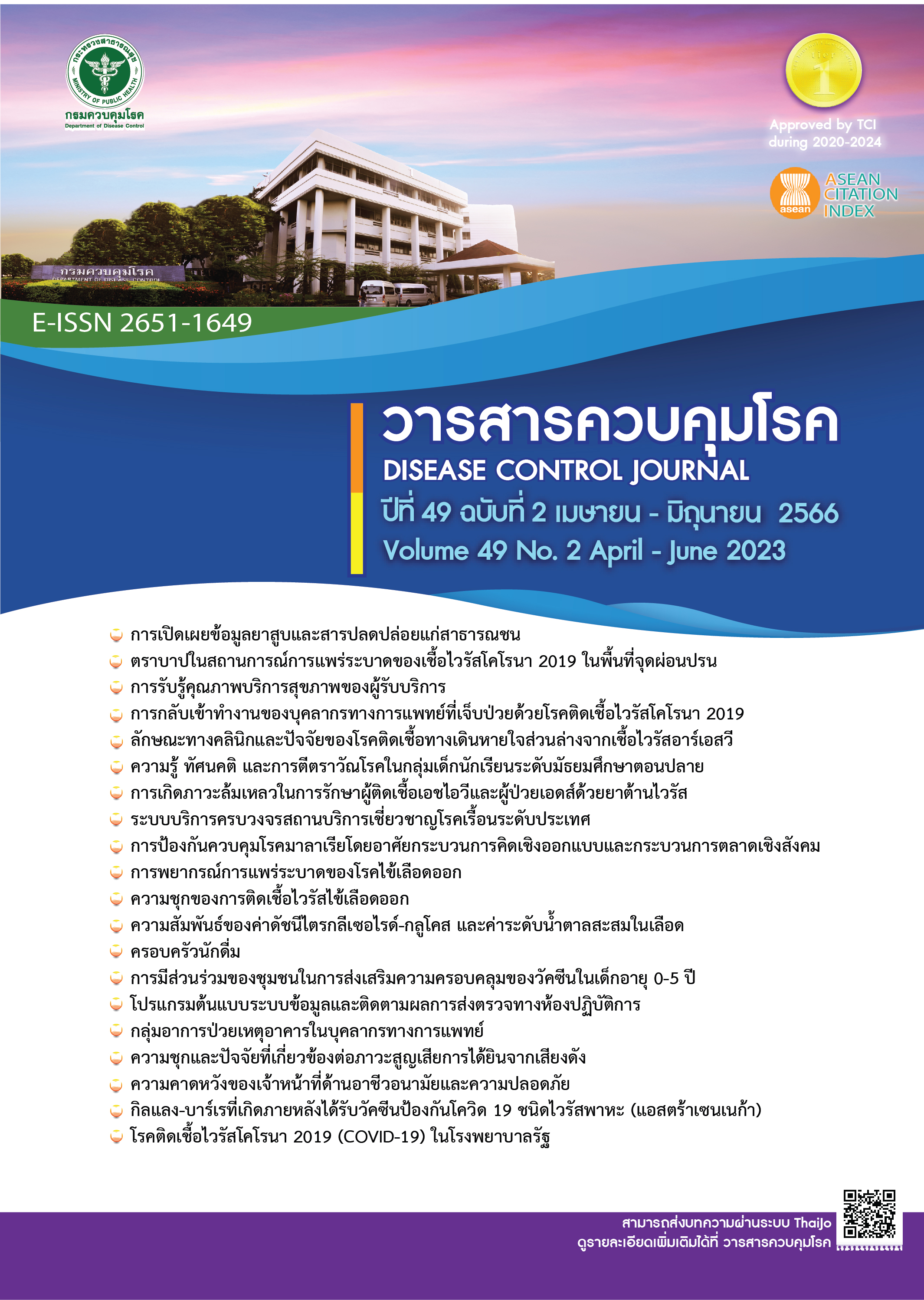Malaria prevention and control innovation based on design thinking and social marketing in malaria elimination management by local administrative organization
DOI:
https://doi.org/10.14456/dcj.2023.29Keywords:
malaria, prevention and control innovation, malaria warning sign, malaria caution sign, public goodsAbstract
The objective of pilot study was to design local malaria prevention and control innovation by making use of malaria warning sign “Beware of Malaria Carrying Mosquito Bite” for persons with occupational and behavioral risks and malaria caution sign “Protect against Malaria Carrying Mosquito Bite” for vulnerable persons, pregnant women, pre-school aged children and rubber tappers. This study employed Stanford’s design thinking and social marketing to provide storytelling of designed signs to 30 purposively selected samples (15 males and 15 females) between January and February 2018 in pilot areas where the malaria outbreak occurred in Nakha Subdistrict, Suk Samran District, Ranong Province. Both malaria warning and caution signs were considered a communication tool essential for increasing awareness of malaria vector among at-risk persons. Based on assessments of participants’ attitudes toward these malaria safety signs, the results clearly indicated that the samples had achieved a high level of average scores for all questions regarding delivered pictures, messages, and colors. In addition, this also implied that the samples had positive attitudes toward using malaria warning sign (yellow plate) rather than malaria caution sign (blue plate). Meanwhile, there was no significant difference in mean scores between males and females with respect to the attitudes of using the malaria safety signs-be it picture, message, or color tone -- with different at-risk persons in the communities. Gender-specific issue did not influence the attitudes of the people and hence all genders could have an equal access to malaria prevention and control innovation, which is economically considered as non-excludable and non-rivalrous public goods for the consumers.
Downloads
References
Bureau of Vector Borne Diseases (TH). Guidelines of malaria elimination for local authorities and health networks. Nonthaburi: Bureau of Vector Borne Diseases; 2018. (in Thai)
Chujun S, Bhumiratana A. Strategic Approach in the Development of Nakha Model for Malaria Elimination Management by Nakha Subdistrict Administrative Organization and Partnering of Nakha Subdistrict-level Network. Journal of Health Science. 2021;30(2):309-19. (in Thai)
Brown JA, White BJ. Modeling desired behaviors: do leaders need new technology? Leadership & Organization Development Journal. 2009;30(2):126-38.
WHO. Harness innovation to reduce the malaria disease burden and save lives. [Internet]. [cited 2022 Apr 28].Available from: https://www.who.int/westernpacific/news-room/events/detail/2022/04/25/western-pacific-events/
The Lancet. Malaria in 2022: a year of opportunity. Lancet. 2022;399(10335):1573.
Liedtka J. Evaluating the Impact of Design Thinking in Action. Academy of Management Proceedings. 2017;1:177.
IDEO. Creating the first usable mouse [Internet]. [cited 2022 Apr 5]. Available from: https://www.ideo.com/case-study/creating-the-first-usable-mouse
Changvittaya A. The evolution of design thinking: from business to academic to community. Veridian E-Journal, Silpakorn University. 2018;11(3):1944-57. (in Thai)
Lee NR, Kotler P. Social marketing: Influencing behaviors for good. Los Angeles: Sage Publications; 2011.
Kaul I, Mendoza RU. Advancing the Concept of Public Goods. Oxford University Press. 2003:78 -111. DOI:10.1093/0195157400.003.0004
Stanford’s d. school. An Introduction to Design Thinking PROCESS GUIDE [Internet]. [cited 2022 Apr 28]. Available from: https://web.stanford.edu/~mshanks/MichaelShanks/files/509554.pdf
Chujun S, Bhumiratana A. Strategic approach to effective brainstorming. Disease Control Journal. 2019;45:115-24. (in Thai)
Weber P, Grauer Y. The effectiveness of social media storytelling in strategic innovation communication: Narrative form matters. International Journal of Strategic Communication. 2019;13(2):142-66.
Likert R. A Technique for the Measurement of Attitudes. Archives of Psychology. 1932;140:1-55.
Best JW. Research in Education. (3rd ed.) Englewood Cliffs, New Jersey: 1977.
Department of Land Transport (TH). Manual for the use of traffic control equipment in the construction area. Nonthaburi: Department of Land Transport; 2011. (in Thai)
Downloads
Published
How to Cite
Issue
Section
License
Copyright (c) 2023 Disease Control Journal

This work is licensed under a Creative Commons Attribution-NonCommercial-NoDerivatives 4.0 International License.
Articles published in the Disease Control Journal are considered as academic work, research or analysis of the personal opinion of the authors, not the opinion of the Thailand Department of Disease Control or editorial team. The authors must be responsible for their articles.






